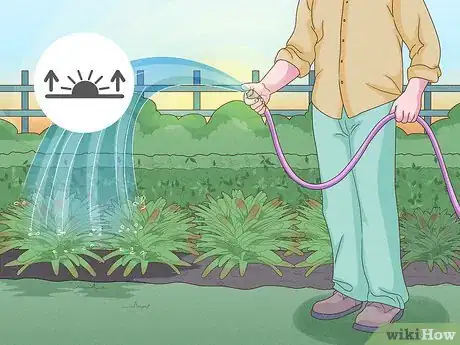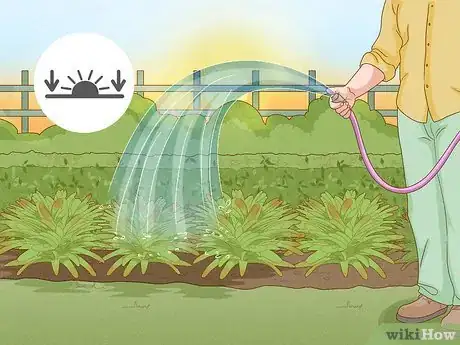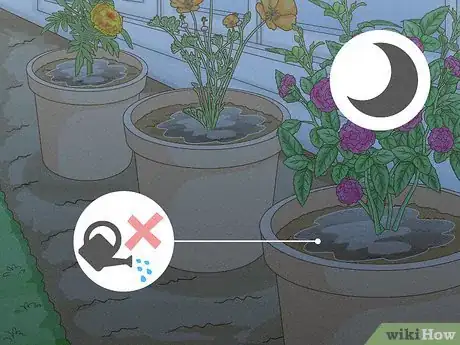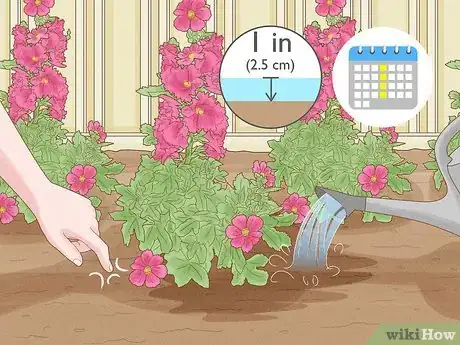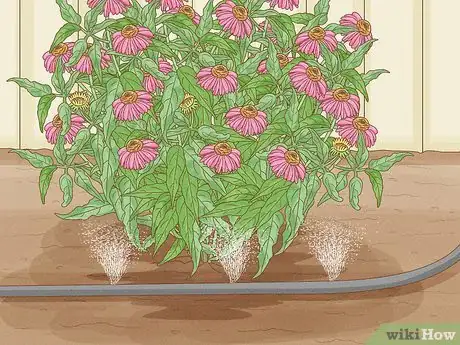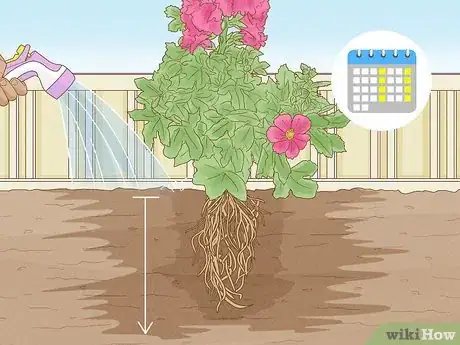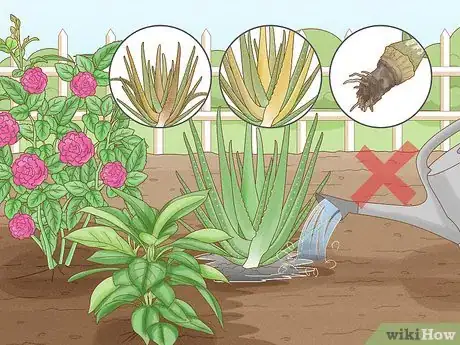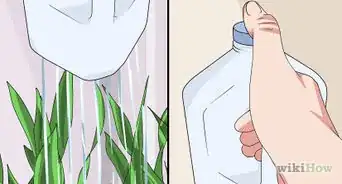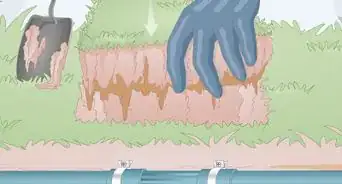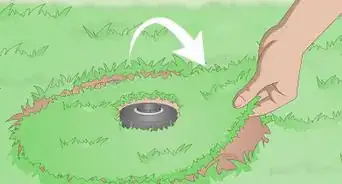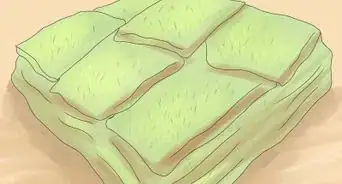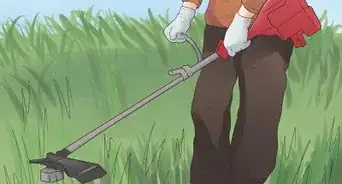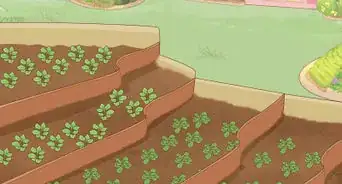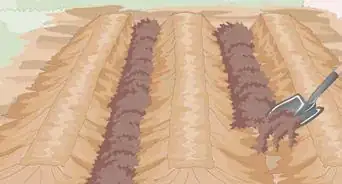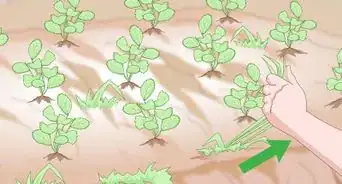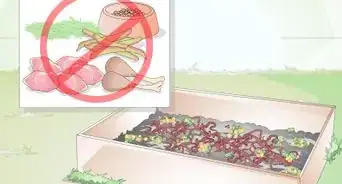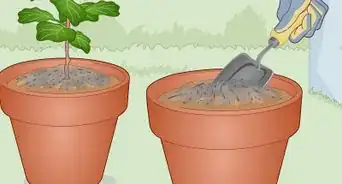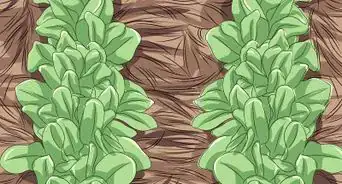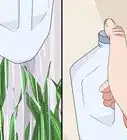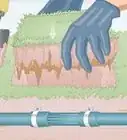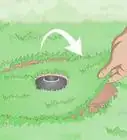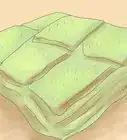This article was co-authored by Andrew Carberry, MPH. Andrew Carberry is a Food Systems Expert and the Senior Program Associate at the Wallace Centere at Winrock International in Little Rock, Arkansas. He has worked in food systems since 2008 and has experience working on farm-to-school projects, food safety programs, and working with local and state coalitions in Arkansas. He is a graduate of the College of William and Mary and holds a Masters degree in public health and nutrition from the University of Tennessee.
wikiHow marks an article as reader-approved once it receives enough positive feedback. This article received 11 testimonials and 99% of readers who voted found it helpful, earning it our reader-approved status.
This article has been viewed 247,886 times.
The best time of day to water a garden is in the morning since that gives the plants time to dry off before nightfall. Leaving water on plants overnight can lead to mold. Watering your garden at the right time and using the right method will keep your plants healthy.
Steps
Choosing the Right Time of Day
-
1Water in the morning if possible. This is the best time to water your garden because it works with the plants' natural growth cycle. The plants are ready to drink early in the morning, when the sun is up but not quite high in the sky. During the rest of the day, they'll be able to drink in the water before the sun gets hot. Hydrated plants are better able to withstand extreme heat.
- If you wait until noon or later when the sun is very hot, the water can actually burn the plants. The sun-heated water will get too hot for the fragile stems and leaves, and it will leave damage in its wake.
- Try to water your garden before 10 am, to make sure the water has plenty of time to seep into the soil and dry a little before the sun gets strong. Watering in the afternoon wastes your water since more of it will evaporate before soaking into the soil.
-
2Water in the late afternoon if the morning is inconvenient. It's not always convenient to water first thing in the morning when you have a million other things to do. If you miss the morning watering, wait until late afternoon, when the sun is no longer at its hottest. This way your plants won't get burned, and there will still be time for them to dry out a little before nightfall.[1]
- If you wait until the afternoon, aim to water from 4 pm on, since before that time the sun may still be strong enough to burn your plants.
- If you absolutely must water when the sun is strong, try to do so only occasionally, rather than making it an everyday habit.
Advertisement -
3Do not water your garden at night. When you water at night, the water sits on the leaves and stems of the plants instead of evaporating. The soil may become water-logged instead of draining properly with help from the sun. This is detrimental to your plants because it leads to mold and fungal growth around the roots and on the stems and leaves.
- Only water at night as a very last resort, if your plants are very thirsty and you can't wait until morning.
- If you must water at night, water the soil to avoid getting the plant itself wet, and use less water to avoid waterlogging. Irrigation tape or a soaker hose makes this much easier.
Using the Right Method
-
1Water your garden with the correct frequency. The general rule for gardens is that they need about one inch of water per week. However, certain types of plants need more water than this, and certain types need less. The best approach is to research your plants' water requirements, and to keep an eye on their health.[2] If a plant wilts, it needs more water.
- Another good test is to insert your finger a few inches into the soil. If it feels completely dry, it's probably time to water. If it's wet just below the surface, give it more time.
- Use common sense when it comes to the frequency with which you water your plants. For example, if it has been a rainy week, your plants don't need as much water. If you're in a drought, they might need extra water.
-
2Water near the roots, not over the leaves. The roots absorb water that nourishes the plant; water that hits the leaves just drips off or evaporates. When you're watering, point the hose, watering can or sprinkler low on the plant, near the roots, to make sure the plant gets adequately watered there.
- Watering over the plant and getting the leaves all wet is also detrimental to the plant's health. Water that sits on the leaves can either cause mold to form or cause the plant to overheat.
- If you find it difficult to water the roots using your hose, look into a special watering system that waters plants close to the ground, such as a soaker hose or a drip-tape irrigation system.
-
3Water long and deep. Most plants are healthiest when their roots grow deep into the ground, rather than growing outward and closer to the surface. Watering deeply, so that you completely saturate the soil, ensures that water gets all the way to the tips of the roots, and it encourages downward root growth.
- That's why it's healthiest to water plants sparingly, but deeply. Instead of watering just a little bit every day, choose one or two days a week to give the plants a good, deep watering.
- That means spending a full thirty seconds or more on each area, rather than just spraying the garden down quickly.
-
4Check for signs of overwatering. Plants that are getting too much water are just as likely to die as plants that get too little water. Make sure you're watering your plants at the correct frequency, and try not to overdo it. Look for these signs that your garden might be getting too much water:
- Leaves that are yellow or brownish at the tips
- Limp, soggy foliage
- Signs of rot
Expert Q&A
Did you know you can get expert answers for this article?
Unlock expert answers by supporting wikiHow
-
QuestionWhy are some leaves yellow on my zucchini plant?
 Andrew Carberry, MPHAndrew Carberry is a Food Systems Expert and the Senior Program Associate at the Wallace Centere at Winrock International in Little Rock, Arkansas. He has worked in food systems since 2008 and has experience working on farm-to-school projects, food safety programs, and working with local and state coalitions in Arkansas. He is a graduate of the College of William and Mary and holds a Masters degree in public health and nutrition from the University of Tennessee.
Andrew Carberry, MPHAndrew Carberry is a Food Systems Expert and the Senior Program Associate at the Wallace Centere at Winrock International in Little Rock, Arkansas. He has worked in food systems since 2008 and has experience working on farm-to-school projects, food safety programs, and working with local and state coalitions in Arkansas. He is a graduate of the College of William and Mary and holds a Masters degree in public health and nutrition from the University of Tennessee.
Food Systems Expert
-
QuestionI read somewhere that the best time to water is between 3 am-6 pm; is this advice correct?
 Community AnswerThat's a very wide time range. Really, this article explains well what the best times to water plants are. The ideal time to water them is in the morning before 10 am. 6 am would be good; 3 am is a bit early but also okay. The worst time to water is between 10 am and 2 pm, when the sun is hottest. Late afternoon through around 6 pm, or even later in the summer when days are long, is okay.
Community AnswerThat's a very wide time range. Really, this article explains well what the best times to water plants are. The ideal time to water them is in the morning before 10 am. 6 am would be good; 3 am is a bit early but also okay. The worst time to water is between 10 am and 2 pm, when the sun is hottest. Late afternoon through around 6 pm, or even later in the summer when days are long, is okay. -
QuestionIs it OK to skip a day of watering?
 Community AnswerIt depends on how dry your plants are. If they are very dry, then water them; but if they are still wet, you can skip that day.
Community AnswerIt depends on how dry your plants are. If they are very dry, then water them; but if they are still wet, you can skip that day.
References
About This Article
To choose the best time for watering the garden, try to water in the morning when the sun is not too hot, so that the water can soak into the soil without evaporating first. If you can’t in the morning, aim to water after 4 pm, so that the sun won’t burn the plant’s leaves if they get wet. Only water your garden at night as a last resort, because if water sits on the leaves or stems too long, mold and fungus could grow and hurt your plants. For tips from our Gardening reviewer on how to tell if you’re overwatering your plants, read on!
